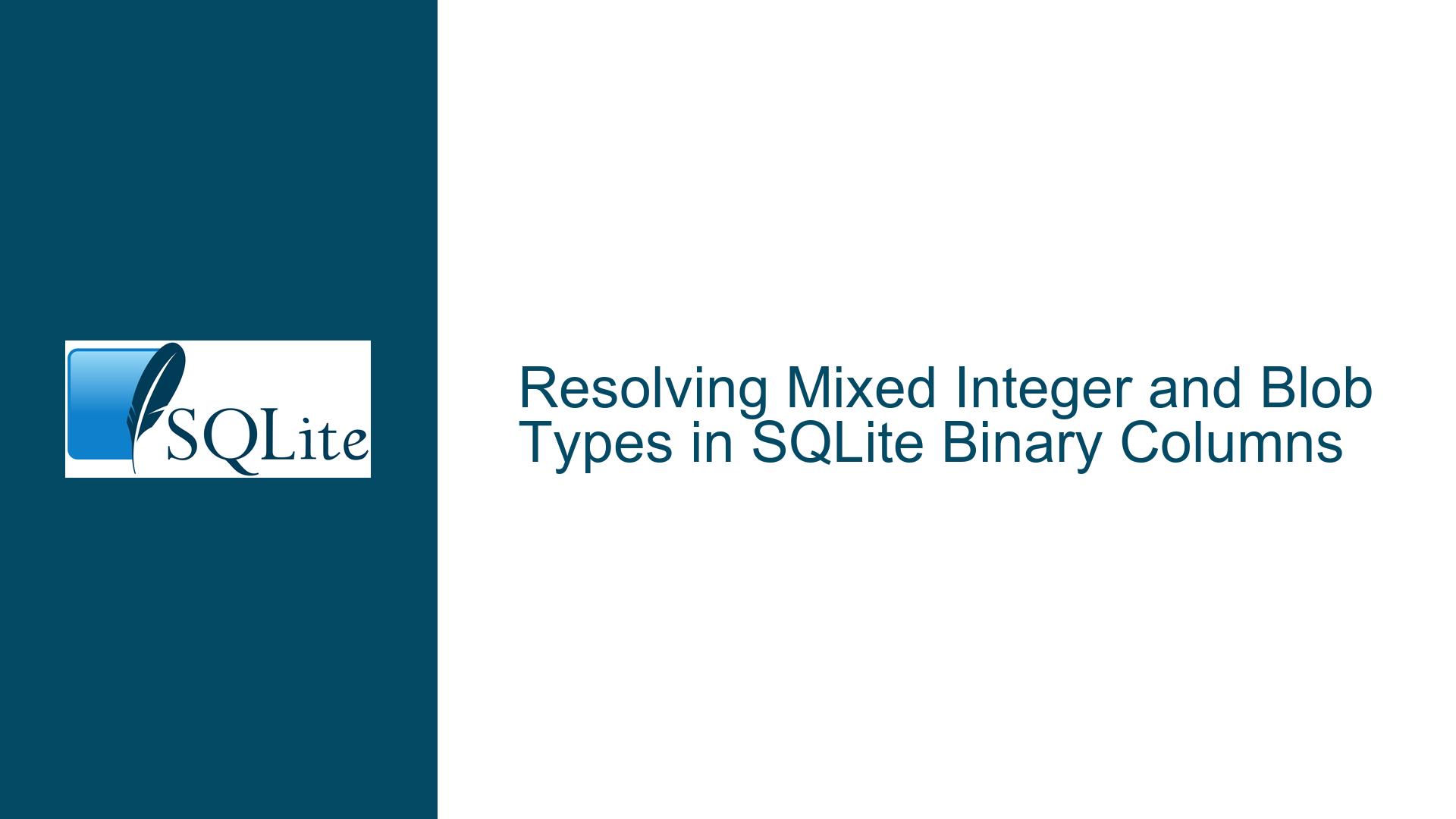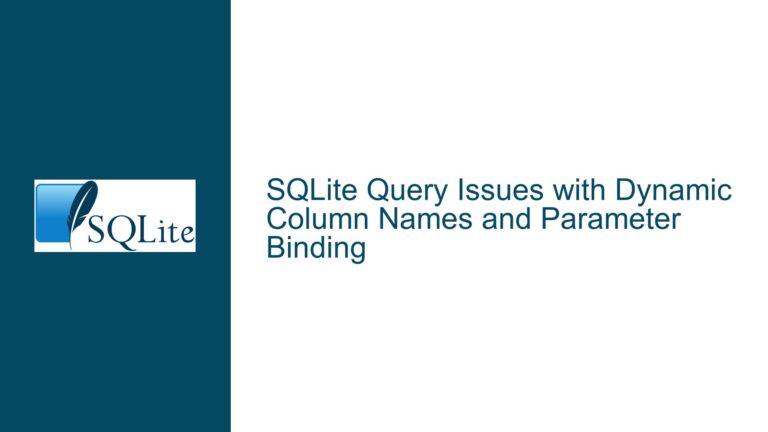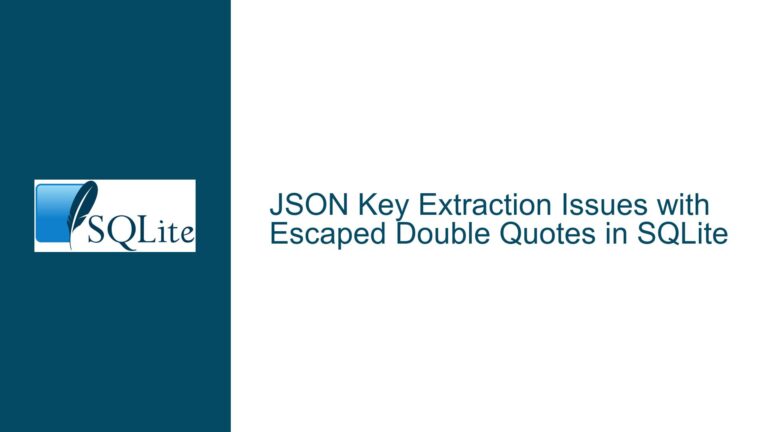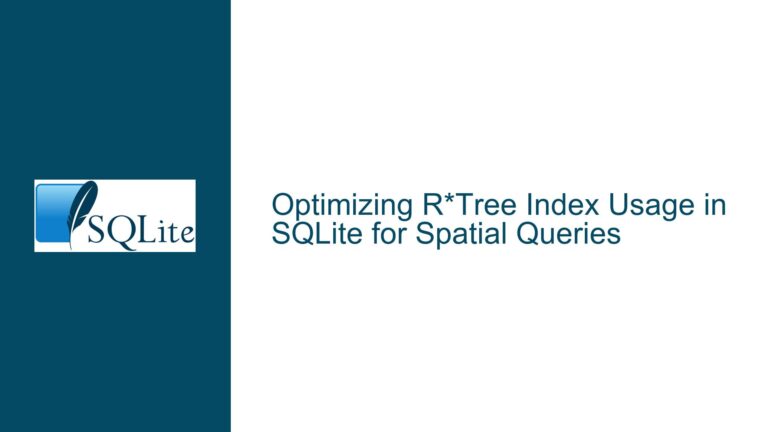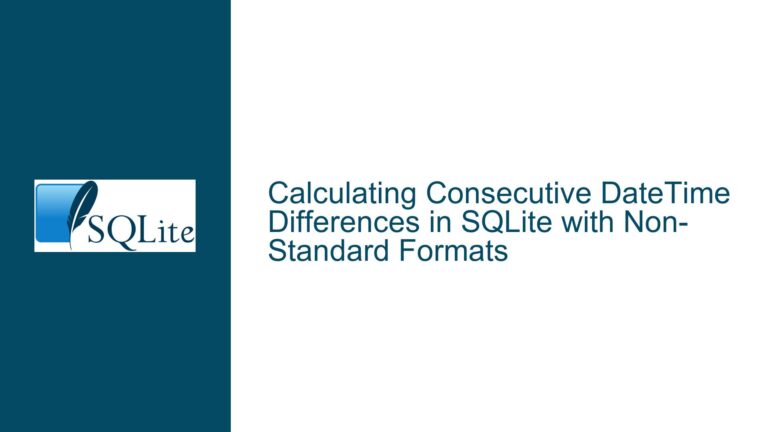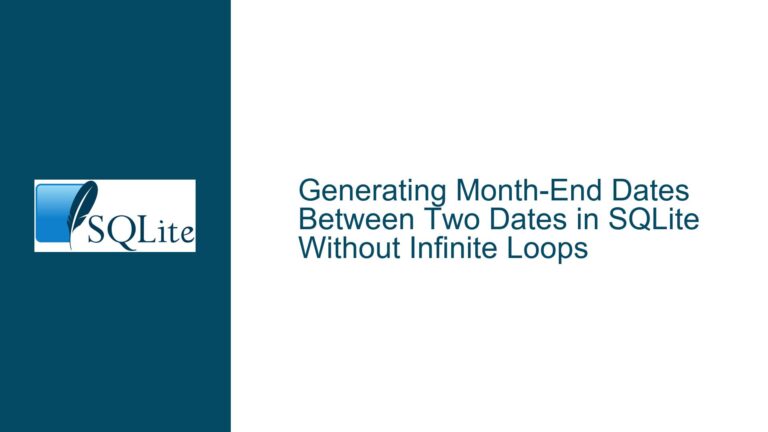Resolving Mixed Integer and Blob Types in SQLite Binary Columns
Understanding Mixed Data Types in Binary Columns and Reliable Conversion Strategies
Issue Overview: Inconsistent Binary Data Storage Leading to Data Corruption
The core problem arises when a column intended to store binary data (such as certificate fingerprints) ends up containing a mix of integer and blob values in SQLite. This inconsistency occurs due to differences in how data is inserted into the column, particularly when importing from external sources (e.g., MySQL dumps, Django applications) or using conflicting insertion methods. The column’s declared type (binary(8) in this case) does not enforce a strict BLOB affinity, allowing numeric and text-like values to be stored as integers or blobs depending on insertion syntax.
For example:
- MySQL-style hex literals (
0x0141202003FFFF01) are interpreted as integers by SQLite. - Explicit blob literals (
X'0141202003FFFF01') are stored as blobs. - ORM frameworks (e.g., Django’s
BinaryField) may use either method, leading to further inconsistencies.
The result is a column where some values are stored as integers (with their decimal string representations converted to blobs) and others as true binary blobs. This creates data corruption when attempting to unify the column’s contents for consistent processing (e.g., hexadecimal rendering, cryptographic operations).
Key symptoms include:
typeof(chr_code)returningintegerorblobfor the same logical data.- Failed conversions when using
CAST(chr_code AS BLOB), which preserves the integer’s string representation instead of its binary equivalent. - Mismatched hexadecimal outputs from
printf('%X', chr_code)(for integers) vs.hex(chr_code)(for blobs).
Possible Causes: Column Affinity Mismatch and Insertion Method Variability
Column Affinity Mismatch
SQLite determines column affinity based on the declared type. The typebinary(8)maps to NUMERIC affinity (due to the lack of a recognized BLOB type qualifier), which allows integers, floats, and blobs to coexist. This means:- Values inserted as hex literals (
0x...) are treated as integers. - Values inserted as blob literals (
X'...') are treated as blobs. - ORM frameworks may use either method, depending on configuration.
- Values inserted as hex literals (
Insertion Method Variability
- MySQL Hex Literals:
0x0141202003FFFF01is parsed as an integer in SQLite, not a blob. This is a critical difference from MySQL’s handling of binary data. - Django ORM Behavior: Django’s
BinaryFieldmay use parameterized queries to insert blobs correctly, but legacy code or migrations might mix insertion styles. - Manual SQL Operations: Ad-hoc inserts or updates without strict type controls exacerbate the problem.
- MySQL Hex Literals:
CAST Misuse
UsingCAST(chr_code AS BLOB)on an integer converts the integer to its text representation (e.g., the string'90388789402271489') and then encodes that string as a blob. This does not convert the integer to its binary byte equivalent. For example:- Integer
90388789402271489becomes the string'90388789402271489', which is stored as a blob of ASCII bytes. - The hexadecimal representation of this blob is
3930333838373839343032323731343839, not the expected0141202003FFFF01.
- Integer
Troubleshooting Steps, Solutions & Fixes: Data Reconciliation and Schema Hardening
Step 1: Diagnose Existing Data Inconsistencies
Run a diagnostic query to identify rows with mismatched types and hexadecimal representations:
SELECT
id,
chr_code,
typeof(chr_code) AS chr_type,
printf('%X', chr_code) AS int_hex,
hex(chr_code) AS blob_hex
FROM certificate
WHERE typeof(chr_code) IN ('integer', 'blob');
Compare int_hex (for integers) and blob_hex (for blobs) to detect discrepancies. For example:
- An integer
90388789402271489may showint_hexas141202003FFFF01, while its blob counterpart would displayblob_hexas0141202003FFFF01.
Step 2: Convert Integer Values to Correct Blob Representation
To convert integers to their true binary equivalents, use a combination of printf, unhex, and padding adjustments. SQLite’s unhex() function decodes a hexadecimal string into a blob, but the input must be properly formatted (even-length, uppercase/lowercase hex digits).
Solution A: In-Database Conversion Using SQL Functions
UPDATE certificate
SET chr_code = unhex(
-- Pad with leading zero if hex string has odd length
CASE
WHEN length(hex_str) % 2 = 1 THEN '0' || hex_str
ELSE hex_str
END
)
FROM (
SELECT
id,
-- Convert integer to hex, stripping '0x' prefix if present
ltrim(printf('%x', chr_code), '0x') AS hex_str
FROM certificate
WHERE typeof(chr_code) = 'integer'
) AS src
WHERE certificate.id = src.id;
Explanation:
printf('%x', chr_code)converts the integer to a lowercase hex string (e.g.,141202003ffff01).ltrim(..., '0x')removes any accidental0xprefixes.- The
CASEstatement ensures the hex string has even length forunhex(). unhex()decodes the hex string into a blob.
Solution B: Programmatic Conversion (Python Example)
For large datasets or complex transformations, use a Python script to handle the conversion:
import sqlite3
import struct
def int_to_blob(value):
# Convert integer to 8-byte big-endian blob
try:
return struct.pack('>Q', value)
except struct.error:
return None # Handle overflow
conn = sqlite3.connect('your_database.db')
conn.create_function('int_to_blob', 1, int_to_blob)
cursor = conn.cursor()
cursor.execute('''
UPDATE certificate
SET chr_code = int_to_blob(chr_code)
WHERE typeof(chr_code) = 'integer'
''')
conn.commit()
Explanation:
struct.pack('>Q', value)converts the integer to an 8-byte unsigned big-endian blob.- The custom SQL function
int_to_blobis registered for use in theUPDATEquery.
Step 3: Enforce Blob Affinity in Schema
Modify the table schema to enforce BLOB affinity for the chr_code column:
-- Create a new table with BLOB affinity
CREATE TABLE certificate_new (
id INTEGER PRIMARY KEY AUTOINCREMENT,
chr_code BLOB, -- BLOB affinity
-- other columns
);
-- Copy data from old table, ensuring chr_code is a blob
INSERT INTO certificate_new (id, chr_code, ...)
SELECT
id,
CASE
WHEN typeof(chr_code) = 'integer' THEN unhex(printf('%016x', chr_code))
ELSE chr_code
END,
...
FROM certificate;
-- Replace old table
DROP TABLE certificate;
ALTER TABLE certificate_new RENAME TO certificate;
Explanation:
- Declaring
chr_codeasBLOBensures future inserts are stored as blobs. - The
SELECTclause converts existing integers to blobs usingunhex(printf('%016x', ...)), which pads the hex string to 16 characters (8 bytes).
Step 4: Validate and Prevent Future Issues
Validation Query
Confirm allchr_codevalues are blobs with consistent hex:SELECT id, hex(chr_code) AS hex_value, length(chr_code) AS byte_length FROM certificate WHERE byte_length != 8; -- Expect 8-byte blobsInsertion Best Practices
- Use
X'...'syntax for blob literals:INSERT INTO certificate (chr_code) VALUES (X'0141202003FFFF01'); - In application code, use parameterized queries with explicit blobs:
# Python example cursor.execute( 'INSERT INTO certificate (chr_code) VALUES (?)', (sqlite3.Binary(bytes.fromhex('0141202003FFFF01')),) )
- Use
ORM Configuration
Ensure frameworks like Django use proper blob handling. For Django’sBinaryField, verify that the database backend correctly uses blob parameters.
Step 5: Handle Edge Cases and Performance
- Truncated Values: If integers exceed 8 bytes, use masking or error handling:
UPDATE certificate SET chr_code = unhex(printf('%016x', chr_code & 0xFFFFFFFFFFFFFFFF)) WHERE typeof(chr_code) = 'integer'; - Performance: For large tables, batch updates with
LIMITandOFFSETto avoid locking:UPDATE certificate SET chr_code = unhex(...) WHERE id IN (SELECT id FROM certificate WHERE ... LIMIT 1000 OFFSET 0);
By following these steps, the mixed-type binary column is reconciled into a consistent blob format, ensuring data integrity and preventing future inconsistencies.
